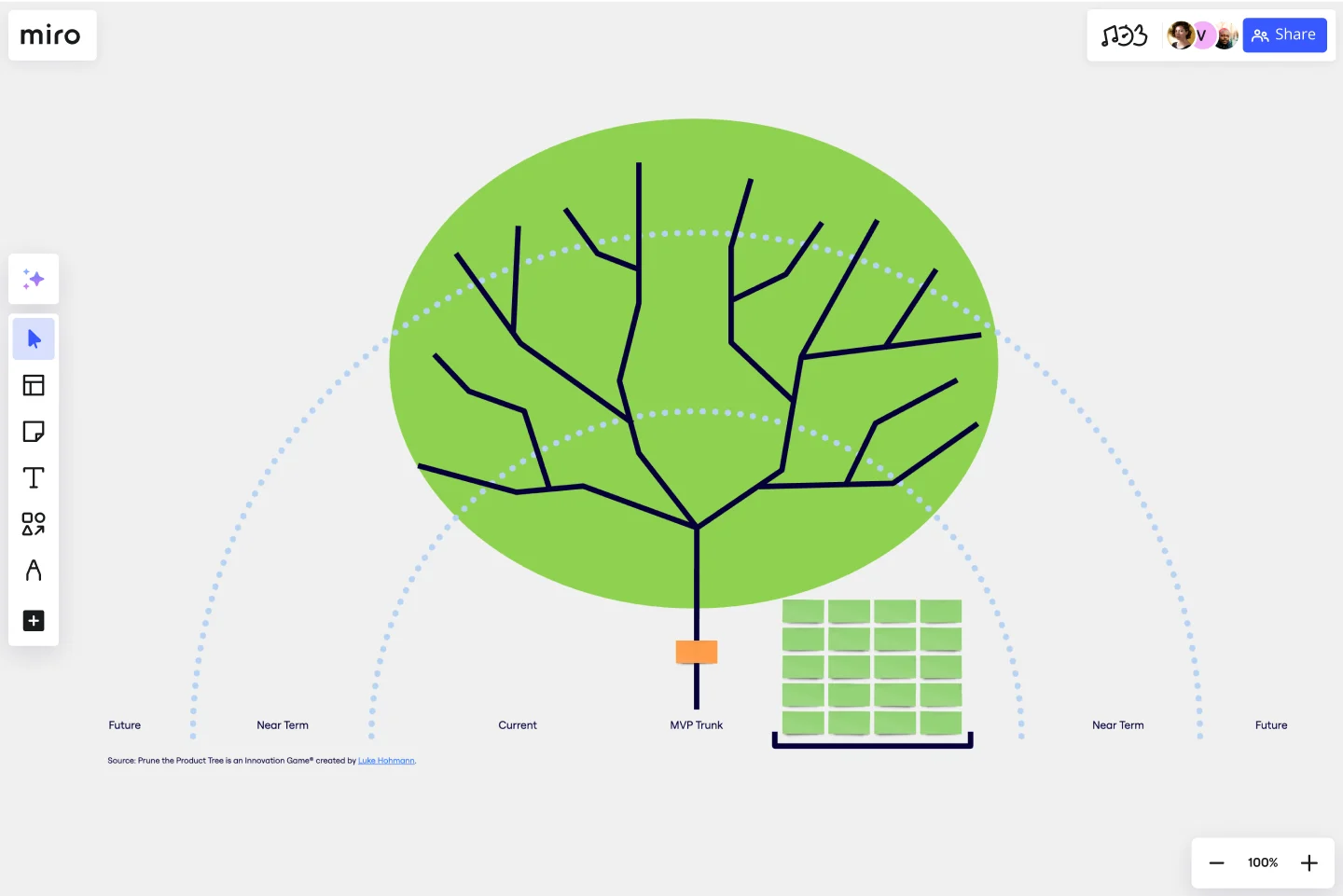Prune the Product Tree Template
Organize and prioritize product feature requests from customers and internal stakeholders.
About the Prune the Product Tree Template
Prune the Product Tree (also known as the product tree game or the product tree prioritization framework) is a visual tool created by Luke Hohmann that helps product managers organize and prioritize product feature requests. The tree represents a product roadmap and helps your team think about how to grow and shape your product or service.
What is Prune the Product Tree
Prune the product tree helps product management teams gamify the juggling of feedback and opinions from customers and internal stakeholders.
A product tree usually has four symbolic features:
Trunk: Existing product features your team is currently building
Branches: Each branch represents primary product or system functions (you can also leave room for more branches to “grow”)
Roots: Technical requirements or infrastructure that make your listed features possible
Leaves: Each leaf represents a new idea for a product feature
You can also adapt the image as needed to suit your team discussions and business priorities. For example, apples hanging off a tree can represent a return on investment, and seed baskets under the tree can symbolize deprioritized ideas.
Create your own version of Prune the Product Tree
Making your own versions of Prune the Product Tree is easy. Miro is the perfect tool to create and share them. Get started by selecting the Prune the Product Tree Template, then take the following steps to make one.
Frame the activity for teams new to the game. For anyone who needs context, spend a few minutes guiding everyone through the exercise. The features found closest to the tree trunk represent near-term priorities. Features on the branches’ outer arms represent long-term future plans. The challenge is to prioritize near-term, current, and future product plans.
Grow each part of the tree to prioritize feature requests. You can cluster groups of features (drafted on sticky notes) around labeled branches or sub-branches (with text boxes). Avoid turning this into an idea generation activity. You want your team to focus on what features are both feasible and desirable.
Discuss each part of the tree as a group. When the tree is full of sticky note “leaves,” you can ask questions to kickstart a productive conversation. Ask each other if anyone thinks branches are too heavy. You can also ask if any feature categories are unexpected, if any feature requirements need more user research, or if the tree roots have the necessary infrastructure to make features viable. Consider dot voting with Miro’s Voting Plugin to figure out what features should be further explored.
Turn the prioritization outcomes into a product roadmap. Prune the Product Tree works as a standalone activity. You can also translate your findings into a product roadmap to shape new features you’ll focus on first from quarter to quarter.
Get started with this template right now.
Empathy Mapping With AI Assistance
Works best for:
Research & Design, Market Research
Empathy Mapping AI Assistance template combines traditional empathy mapping with AI insights. This innovative approach helps you understand user needs by integrating data-driven insights with human empathy. Use this template to enhance your product development process and create more personalized user experiences.
UML Diagram Template
Works best for:
Diagrams, Software Development
Originally used as a modeling language in software engineering, UML has become a popular approach to application structures and documenting software. UML stands for Unified Modeling Language, and you can use it to model business processes and workflows. Like flowcharts, UML diagrams can provide your organization with a standardized method of mapping out step-by-step processes. They allow your team to easily view the relationships between systems and tasks. UML diagrams are an effective tool that can help you bring new employees up to speed, create documentation, organize your workplace and team, and streamline your projects.
Retrospective - Christmas Edition
Works best for:
Agile Methodology, Retrospectives, Meetings
The Retrospective Christmas Edition template offers a festive and themed approach to retrospectives, perfect for the holiday season. It provides elements for reflecting on the year's achievements, sharing gratitude, and setting intentions for the upcoming year. This template enables teams to celebrate successes, foster camaraderie, and align on goals amidst the holiday spirit. By promoting a joyful and reflective atmosphere, the Retrospective - Christmas Edition empowers teams to strengthen relationships, recharge spirits, and start the new year with renewed energy and focus effectively.
Likert Scale Template
Works best for:
Desk Research, Decision Making, Product Management
It’s not always easy to measure complex, highly subjective data — like how people feel about your product, service, or experience. But the Likert scale is designed to help you do it. This scale allows your existing or potential customers to respond to a statement or question with a range of phrases or numbers (e.g., from “strongly agree” to “neutral,” to “strongly disagree,” or from 1 to 5). The goal is to ask your customer some specific questions to turn into easy-to-interpret actionable user insights.
Agile Product Roadmap (Now, Next, Later)
Works best for:
Product Roadmap
Stay ahead in your product development with the Agile Product Roadmap Now Next Later template. This tool allows you to plan and prioritize features and improvements dynamically, ensuring your product evolves with market needs. Visualize short-term, mid-term, and long-term goals to keep your team focused and aligned. Perfect for product managers and agile teams aiming to deliver continuous value.
Empathy Map Template by Jeshua MacDonald
Works best for:
Market Research, Research & Design
The Empathy Map template is essential for anyone looking to understand their audience better. It helps you gather insights into user thoughts and behaviors, allowing you to design more user-centered products and services. Perfect for UX designers and marketers.
